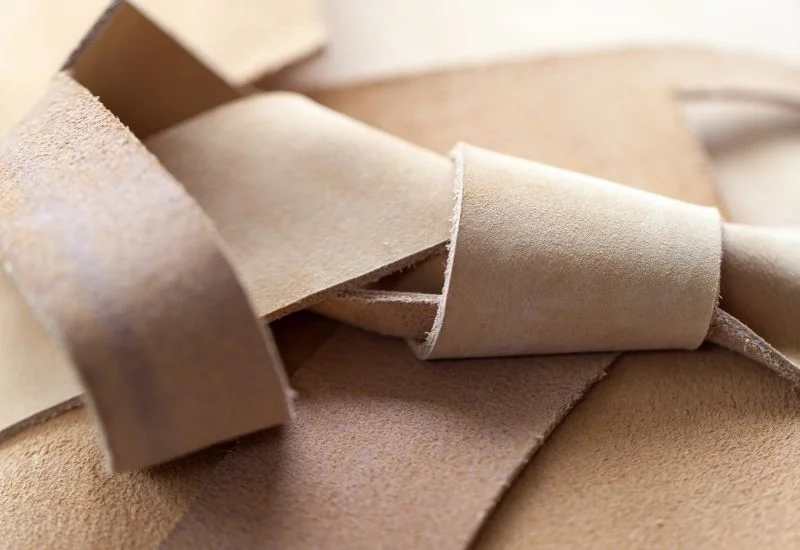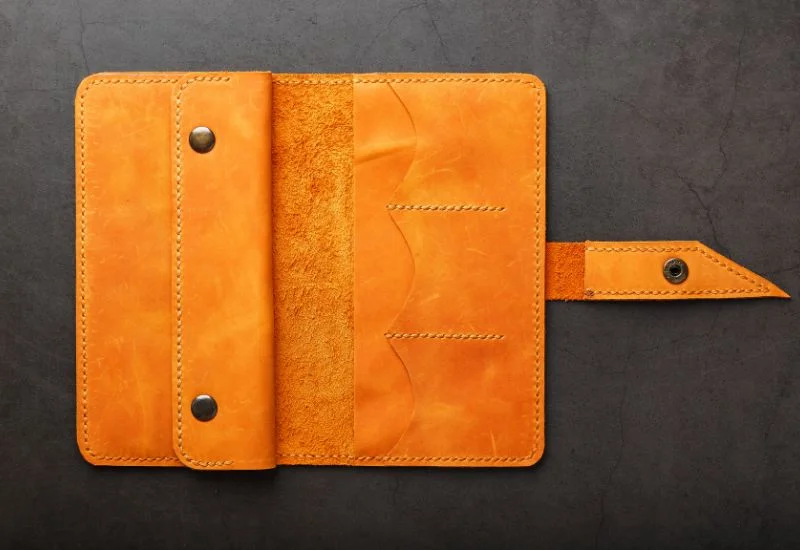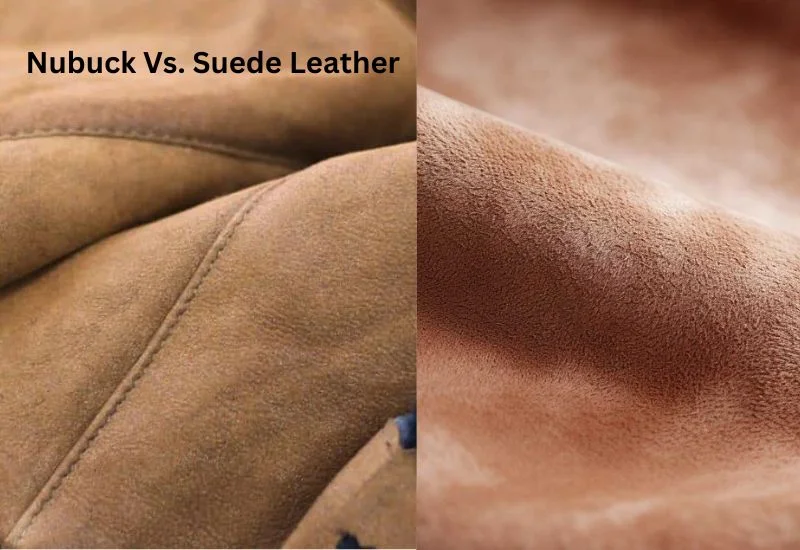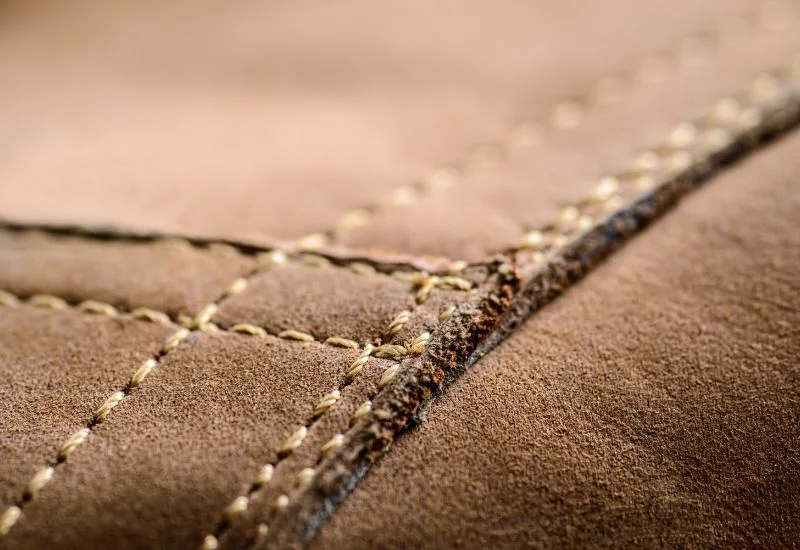
Edited by Abdullah Faraz on July 27, 2024
Have you ever visited a shop and wondered about the difference between nubuck and suede leather? While nubuck is a relatively new word for some people, it has roots in historical eras.
Nubuck leather is produced after removing the external layer of animal hides. Its soft and velvety appearance makes it unique compared to other leather materials.
This article gives you in-depth knowledge about the origin of nubuck leather, its usage, pros and cons, and how to care for it. Let’s dive in and learn something new about nubuck leather material.
Introduction to Nubuck Leather
Nubuck leather is a soft and smooth leather made from the top grain of an animal hide. It possesses an exquisite look and feel that attracts many people. It is used in a wide variety of products, namely shoes, furniture, and jackets.
It looks similar to suede but is quite different from it. Its fibrous texture is the reason for comparing the two leather materials.
Nubuck leather is a superior-quality material used in the fabrication of expensive essentials. It has been a symbol of excellence and luxury in the past and present.
History of Nubuck Leather
The evolution of leather craft started with the creation of various kinds of leather material. But nubuck leather was still in use centuries ago. People used nubuck leather due to its soft appearance and longevity.
Nubuck is derived from the German word “nappa,” which means “to roughen”. It is a combination of two words, “new” and “buckskin”.
The use of nubuck leather is evident in ancient historical ages due to its velvety appearance. Buffing the external surface of the leather generates a velvet-like appearance that is usable in creating many expensive items.
The production methods of nubuck leather advanced with the Industrial Revolution. People used different techniques and processes to form the material. Advanced technology and manufacturing methodologies were the main reasons for its greater production1.
Fabrication of Nubuck leather

Calfskin or cowhide is essential to make this leather. In the past, buckskin was the main component in its synthesis.
Tanning
Remove the top layer of the skin to form the premium leather product. Nowadays, tanneries use advanced machinery to separate the top layer from the animal hides.
This exposes fibers to the leather surface, which is then shortened to give it a velvet appearance.
Sanding
The protein fibers released by removing the top layer undergo the buffing or sanding process, which shortens the fibers and smooths the outer surface. The surface becomes soft, giving a velvet or suede-like appearance.
Some consumers generally require a soft and irregular appearance, which gives the product a vintage look. Others prefer a plain single-color pattern.
Dye and Staining
Staining conceals scratches, flaws, and imperfections in the leather. Dye or staining hides the spots and gives the nubuck leather a smooth finish.
This is preferable when using Nubuck leather to make expensive, luxurious items like apparel, shoes, and furniture2.
SUMMARY
Nubuck leather, crafted from calfskin or cowhide, undergoes tanning and sanding to achieve its signature soft, velvet-like surface. Advanced machinery separates the top layer of hides, exposing and buffing protein fibers for a smooth finish. Dyeing and staining processes enhance its luxurious appearance.
Advantages of Nubuck Leather
Is it worth paying extra for this leather material? If you prefer a material with many benefits, nubuck leather may be worth the investment. It easily justifies its price tag over time.
The main advantages of using nubuck leather are as follows:
Resilience
Nubuck is famous for its long-term durability and toughness. Made of the toughest part of the animal hide, it can easily withstand harsh conditions without wearing out.
It is tough and can be made more liquid-resistant through treatments, making it suitable for many products, such as shoes, sofas, and belts. The presence of top grain is a standout factor in increasing the shelf life of nubuck leather.
Breathability
Nubuck leather is more breathable than other synthetic leather products. This is due to its porous structure.
When the upper layer of the animal hide is removed, it exposes the fibers that create the porous structure within the leather. This structure allows the passage of air, making it usable in many goods.
Appearance
Nubuck has a natural appearance due to the use of genuine leather. The imperfections are avoided by staining the leather with a suitable color gradient.
Overall, its smooth appearance makes it more attractive than other leather materials. This is a major factor in increasing the price tags of nubuck leather products.
Maintenance
Nubuck leather is a low-maintenance leather product. As it is made of genuine leather, customers usually prefer a vintage appearance.
The upper surface can be easily cleaned using water or a fabric cloth. Regular cleaning or polishing of this leather is also not necessary3.
Quality
It is made of durable top-grain material, which makes it superior to its competitors. It is also soft and very comfortable, and the softness is due to the fibers of the calfskin.
Nubuck products are comfortable to use due to the soft protein fibers on the top layer. The sanding process ensures the softness and velvety appearance of the nubuck leather.
Disadvantages of Nubuck leather
There are some disadvantages of nubuck leather, but the benefits outweigh them. Discussing the limitations provides a broader picture while selecting the best leather material for yourself.
Stains
Nubuck leather is susceptible to stains. Grime, oil, and grit are the main reasons for stains on the external layer of leather.
It destroys the overall look of the product, making it unsuitable in areas exposed to debris and mud.
Cost
Nubuck leather is an expensive material as compared to other leather products. The price hike is due to the use of the strongest part of the animal hide.
Nubuck leather has a vintage and classy appearance that is more aesthetic than other products. People are usually willing to pay more for genuine leather.
No Patina
It is not a drawback in itself, but it generally depends on customers’ choices. Industries develop both kinds of nubuck weather: one buffed and the other without the sanding process.
Buffing the outer surface of the leather vanishes the patina, and the material will not give a vintage appearance in long-term use. This is a turn-off for some customers.
Many individuals prefer that their leather products age well with time, giving them a unique appearance. For this purpose, it is advised to use nubuck leather synthesized without buffing the upper surface.
Scratches
Small scratches do not affect the appearance of the nubuck leather. Leather lovers generally prefer a rugged appearance.
Scratches on the top surfaces of the nubuck leather affect the protein fibers. Hard scratches may remove the fibers from their place, leading to the abrasion of the leather product.
Nubuck leather is not easy to scratch, but it is advisable to protect the leather product in harsh conditions.
Uses of Nubuck Leather
The history of nubuck leather shows that it is always linked with fashionable figures and aristocracy. This leather material is used in both luxury products and a wide range of less-exclusive products.
Apparel & Fashion Industry

Clothing products made of nubuck leather are a graceful and stylish choice, especially jackets and coats. Their smooth, velvety, and suede-like appearance gives the apparel products a luxurious feel.
It provides a classy, vintage touch to apparel. The product’s shelf life automatically increases with the use of nubuck leather. It differentiates coats or jackets from normal clothing products of the same style.
Nowadays, nubuck is also used to fabricate caps, belts, and purses. The addition of this leather material to casual attire products maintains the brand’s high quality.
Footwear

When it comes to footwear, nubuck leather is one of the most popular choices. Its tear-resistant and breathable properties allow it to be used extensively in this sector.
It is perfect for extreme weather conditions. Because of its longevity and tear-resistant properties, long boots and hard-shelled shoes are made with this material.
Nubuck adds a luxury and aesthetic appearance to footwear products. Thus, you can enjoy a luxury product with extensive features.
Furniture
A wide range of upholstery, armchairs, and sofas made from nubuck leather offer a smooth and comfortable sitting experience. The natural velvety texture of the leather adds warmth to the room. It looks exquisite and fashionable. However, it does need to be cared for, as external textures can wear out.
Bags
Nubuck leather is used in the manufacturing of various types of bags, including backpacks, shoulder bags, sling bags, and travel bags. People who travel a lot love bags made of nubuck, as they add a sense of elegance, and their compact design enables the user to carry additional stuff with ease.
Its minimalistic look and soft feel are aesthetically pleasing to the eye. Some bags develop a patina over time that adds beauty to them. This type of leather is used to synthesize sturdy and classic leather bags.
It usually lasts a long time and is a great investment product. This type of leather is also used to develop other bag-related products, such as duffles, briefcases, and handbags. It makes a perfect gift for any occasion.
Gloves
People living in cold areas excessively use leather gloves to protect their hands. A high-quality pair of gloves is durable, warm, and soft on the inside. Nubuck leather serves just the right purpose.
Animal hide does not allow cool air to pass through the skin. Additionally, it looks classy to wear. When buying a pair of gloves for yourself, always consider the option of nubuck leather if available. It will be worth your money.
How to Care for Nubuck Leather?
Nubuck is a low-maintenance leather material that takes less time to clean. However, the soft upper layer needs to be cleaned with proper care; otherwise, it might be torn easily. Follow the below-mentioned steps for easy care and cleaning of any nubuck leather product.
Bristle brush
Use a soft bristle brush to clean the surface of the leather product. Slowly rub the brush in circles on the dirty area. A soft fabric specially formulated for cleaning nubuck leather is also used.
It removes excessive dirt and debris from the leather surface, leaving only the stain marks.
Stains
If you notice a minute stain or dirt mark on the nubuck leather, clean it with a soft cloth. The cloth needs to dry so that it can absorb the stains. Avoid rapid rubbing of the fabric, as it only increases the stains.
Clean the stain area gently using specific products made for nubuck leather. You can easily find cleaning agents only used to remove stains on this leather material.
Water
Avoid using too much water during the cleaning process. It damages the soft fibers present on the leather surface. Using water directly during the cleaning process is also not a good practice.
Specific waterproof sprays are available to clean nubuck leather. Rub a damp cloth over the stain area and repeat the process if necessary.
Sunlight
Taking nubuck leather out in excessive heat and sunlight is not a good practice. Nubuck gets dry and worn out in sunlight, which ultimately leads to the fading of leather color.
Storage
Place the bags, upholstery, shoes, or gloves in a cool and dry place. Nubuck leather remains intact in a breathable storage area. Do not store it in locked cabinets for a long time. This causes dust accumulation that is not suitable for leather surfaces.
Nubuck Vs. Suede Leather

It is crucial to understand the basic differences between suede and nubuck leather. Both look similar due to the sanding process, but the main difference lies in their manufacturing materials.
Material
Suede leather consists of the inner soft portion of cowhide leather. Nubuck leather is used to make suede leather products.
Synthesis Process
The inner layer of the animal hide is separated and cleaned. This is followed by sanding, which provides a smooth and soft outer surface of suede.
Because of its soft material, it needs extra protection material. Avoid placing it in water or direct sunlight, as it fades quickly.
On the other hand, nubuck is synthesized using thick animal hides. Excessive tanning and sanding processes give it a smooth and velvety appearance.
It is more durable and soft than its competitor. If handled with care, it is also long-lasting4.
Physical Properties
Suede is a thinner leather material. It is lightweight and easily damaged. The outer layer of suede leather is waxed to increase its shelf life. Waxed suede leather is usable in products like shoes, bags, gloves, furniture, etc.
Nubuck leather is heavier and stronger. Its external surface has protein fibers that give it a classy look. Pure cowhide leather is used in its manufacturing. Some people like its vintage look, while others prefer dye or stain variants of nubuck leather. Even after many years, it looks flawless and brand new.
Nubuck Vs. Genuine leather
Typically, leathers do not have a smooth and sturdy finish like nubuck or suede leather. This is a major key difference between full-grain and nubuck leather. Long protein fibers on the outer layer give a soft and smooth experience that is not characteristic of a genuine leather product.
Appearance
Genuine or full-grain leather features the original marks of the animal skin. People love it. Because it gives their products a unique appearance, it is rough to touch and has been impossible for many years.
It is rich in patina. As time passes, the patina develops onto the surface, giving it a vintage vibe.
Nubuck is soft and velvety to the touch due to the brushing and polishing done on the outer surface. The additional synthesis steps are the cause of major differences between the two.
Quality
Full-grain leather is an authentic, rich leather product that provides a higher-quality experience. It is the most elite kind of leather product in the market. The use of high-quality animal skin gives it its unique design and high strength.
Nubuck has many quality variants that depend on the cowhide material used during manufacturing. Quality differences are clearly visible in local and international nubuck leather products. Vendors manufacture products according to customer demand5.
Maintenance
Nubuck is hyped because of its smooth appearance, which needs to be maintained over time. Regular cleaning is necessary to protect the leather products from dirt and grime.
Genuine leather needs less protection due to its high-quality, strong leather material, which protects it in harsh environments. It is rough to the touch and does not develop stains easily.
Conclusion
Nubuck is a high-quality leather material famous for its exquisite appearance. Its satin or velvety outer surface gives leather products a luxurious feel. Due to its high quality, nubuck is also quite expensive. Upholstery, sofas, shoes, and bags are common products made of nubuck.
If you are looking for a premium-quality, low-maintenance leather material, this is the ideal choice. It has many qualities that make it worth the price tag.
Now you know all about nubuck leather, its manufacturing process, its characteristic features, and its uses. This article will help you purchase a nubuck leather product for yourself.
So, What do you think of Nubuck leather? Be sure to leave a comment below!
Frequently Asked Questions
Article Sources
Bagsbucks provides reliable information with good-quality references to support the facts.
- What is Nubuck Leather? The Definitive Guide. The Real Leather Company. ↩︎
- What is nubuck? Everything You Need to Know. Carl Friedrik. ↩︎
- Here’s everything you need to know about nubuck leather!.Olpr.
↩︎ - Nubuck leather – Everything you need to know. Crafted Society. ↩︎
- Nubuck, Suede, and Leather. What’s the difference?.LeatherNeo. ↩︎
